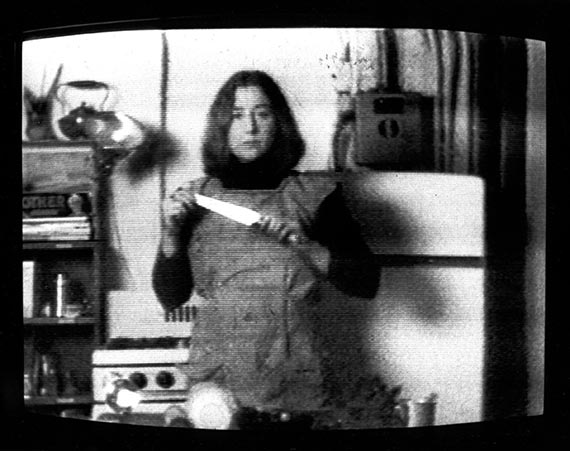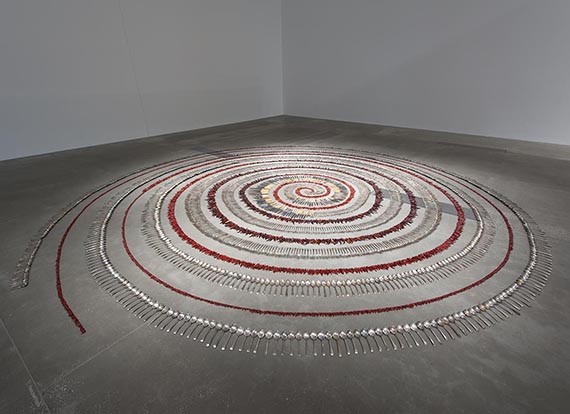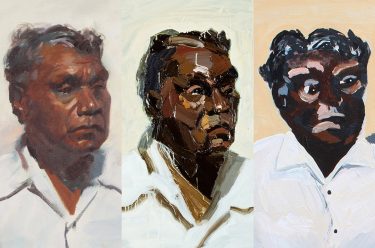
The nature of what we eat as well as the abundance or absence of food is indication of culture and class. As powerful social marker the distribution, production and control of food will always be packed with politics. ‘Harvest’ looks at art on the subject of food and farming, spanning across time and reaching to all corners of the world.
‘The personal is political’ is a mantra that encapsulates the second wave feminist movement, and can be thought of in relation to everyday subject of food. Although this may no longer be the case for some, women traditionally occupied the service role between the production and consumption of food. The American feminist artist Martha Rosler squares up to the oppressive framing of women in the kitchen in her video work, Semiotics of the Kitchen 1975, which is currently featured in ‘Harvest’. In the work, Rosler presents a deadpan demonstration of an alphabet of utensils in the style of a cookery show. But there is no food here, the artist ties up her ‘A-pron’ and then manically stirs empty pots and stabs the bench with an ice pick. Rosler makes a mockery of ‘doing things the correct way’. Rosler uses the items in a tactic that does not match up with their intended function or their context within the kitchen. The meaning and use of the utensils are violently torn from their proper names, wielded as swords of disagreement in droll, frenzied displays of impracticality.
Women have assumed new roles in every sphere of public life and are no longer defined by a life of domesticity. But Rosler does not only object to the position of the housewife, she is resisting any oppressive naming or stereotyping or definition of woman, for example the role of mother/daughter and all of the assumptions and expectations that go along with such labels. Rosler has commented that she puts ordinary items to work as decoys: ‘something that takes a familiar shape but attracts people toward something else’. The feminist and the kitchen were traditionally at odds with each other, but in Semiotics of the Kitchen Rosler brings them together to talk. The kitchen for this feminist is not a negative place but a powerful space for revolt.

The reassessment of everyday habits and artifacts can reveal a lot about the miniscule details of life that enforce power structures and inequality. Another artist in the ‘Harvest’ exhibition, Simryn Gill also brings items from the kitchen into the gallery space. Gill refers to her use of everyday objects in her art practice as an assembling and juxtaposition of ‘the residue of living’. Gill has a personal history of relocation, variously living in Malaysia, India, UK, and Australia, and the notion of shifting identity and culture is a common theme her artistic practice. Gill’s installation work, Forking Tongues 1992 is a swirling arrangement on the floor of the gallery, a line of silver and bone handled cutlery winds beside band of dried red chilies. Silver cutlery was introduced to Asia by European colonisers and is a reminder of the misguided civilizing ambitions of these migrants. Although now emblematic of South East Asian cuisine, chilies were brought to Asia in the sixteenth century through Portuguese migration.
In this intertwined formation, Gill evokes the movement and circulation of food and cultural practices across place and time. The everyday items share a loaded history of the influence of the importation of object and migration of people on notions of cultural identity. The artist shows the inconsistency of what can be classified as exclusive to a national culture. Or indeed, any form of collective identity. Identity rather is always changing with time, place and space. And culture is not a fixed story but is rich in diverging histories.
Today, such cultural exchange can be observed on every kitchen table in Australia. The global village has expanded the realm of culinary possibility – unfamiliar ingredients and techniques are easily researched online, passed on, embraced and appreciated. Cultural identity, like Rosler’s woman-in-the-kitchen, cannot be tied down. These artworks rethink everyday objects and their commonplace meanings when presented to the world as art.

